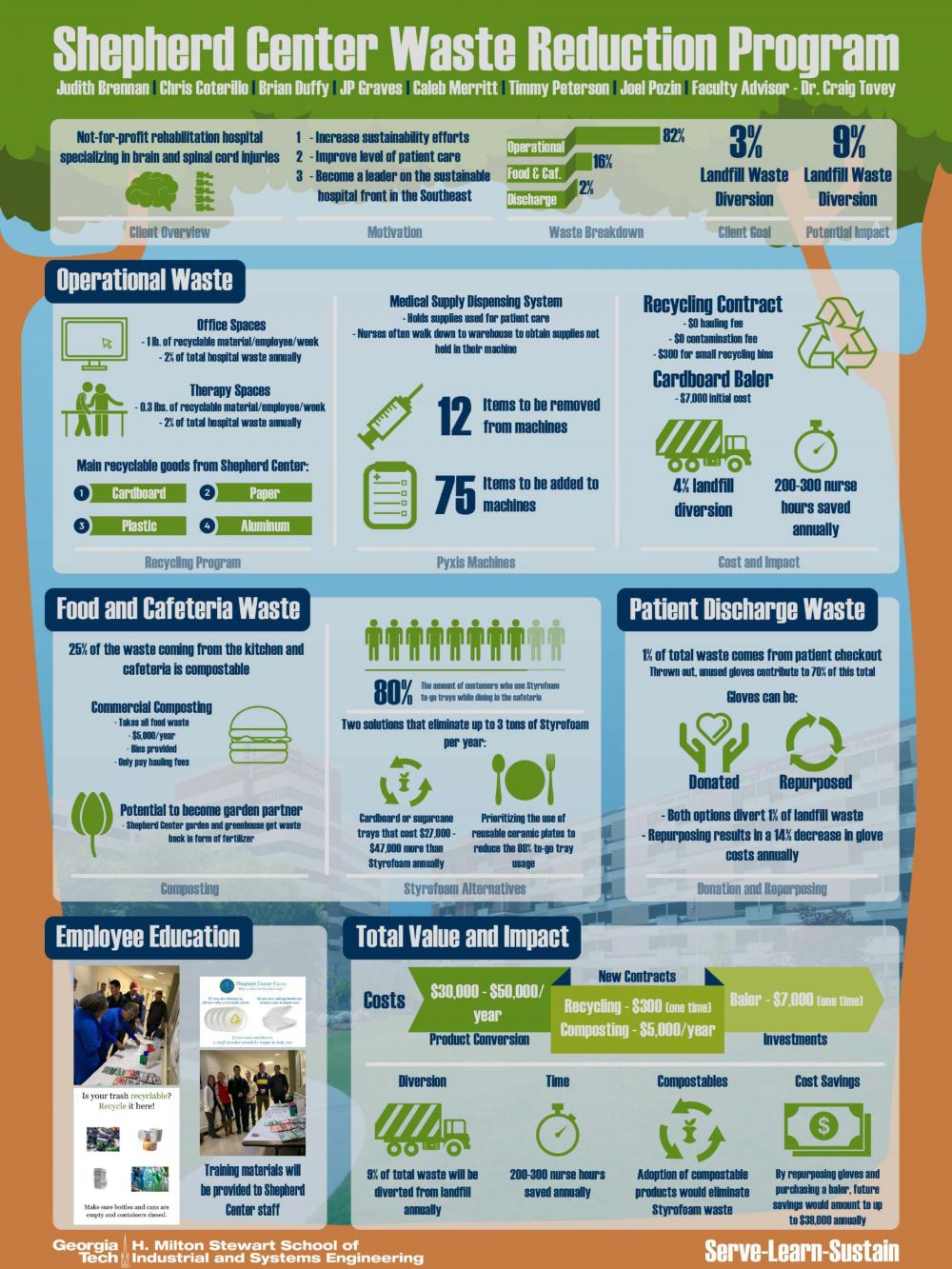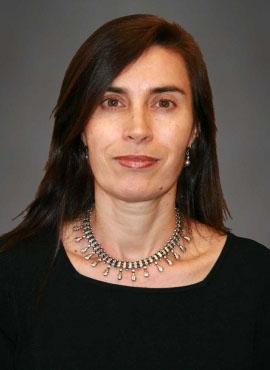Client Context
Shepherd Center is a non-profit rehabilitation hospital in Atlanta specializing in brain and spinal cord injury. Shepherd Center sees approximately 900 inpatients and 540 day patients annually. The hospital employs 1,765 employees and utilizes 230 volunteers. In 2018, Shepherd Center discarded approximately 550 tons of waste, all of which went to landfill. Shepherd Center's Sustainability Committee sought to reduce waste tonnage sent to landfill through the creating of a waste reduction program.
Project Objective
Shepherd Center's Sustainability Committee sought to reduce the amount of waste the hospital sends to landfill while becoming a leader in sustainability among hospitals in the Southeastern United States. Upon analysis, the three main areas of waste in which Shepherd Center could significantly divert waste from landfill were: cafeteria waste, patient discharge waste (i.e. gloves, pillows, gowns, etc.), and operational waste (general waste from hallways, break rooms, office spaces, etc.). Cafeteria waste accounts for 90 tons of the 550 tons discarded in 2018. 20 of the 90 tons is from food waste and 3 tons is from Styrofoam trays. While patient discharge waste accounts for 7 tons of the annual waste, 5 tons are from unused gloves and presents the greatest opportunity for monetary savings. The remaining 418 tons are classified as operational waste of which 22 tons is recyclable. This project sought to design procedures to reduce Shepherd Center’s waste and determine partners to work with Shepherd Center in implementing these procedures.
Design Strategy
The team obtained paper invoices of waste production from the center to determine the amount of annual waste produced, as well as paper records of purchases at the center. Purchase records were used to determine what supplies are being ordered in excess. After establishing a waste breakdown of operational, cafeteria, and patient discharge waste, the team explored options to reduce the waste.
To determine Shepherd Center’s annual recycling capability, we ran a recycling trial in an office space and a therapy floor, where patients stay and receive care. The data was extrapolated to represent the recycling potential of Shepherd Center’s employees. We then sought out potential recycling providers and, along with the client, decided WestRock is the best provider for Shepherd Center. Upon this recommendation, Shepherd Center agreed and is in negotiations with WestRock. The implementation of a recycling program requires employees to take additional time to recycle. To encourage recycling, we looked at the storage within the Pyxis machine, which store supplies needed for patient care. Nurses are the most frequent user of the Pyxis machines and have the busiest schedule of the employees. Not all of the supplies nurses need to administer care are located in the Pyxis machines, causing the nurses to travel to the warehouse on the basement floor to get supplies. By identifying items that can be removed and items to be added to the Pyxis machines, nurses save time in their schedule. Given the savings in time, the nurses will be more likely to recycle.
In the cafeteria, general cafeteria waste was weighed, and leftover food waste was analyzed. Initially, we looked into potential organizations to take food donations from the cafeteria. However, the organizations contacted were at capacity. We then contacted composting providers. Along with the client, we determined CompostNow was the best provider for Shepherd Center. Upon this recommendation, Shepherd Center agreed and is in negotiations with CompostNow.
To address Styrofoam usage, we began by observing the number of customers eating in the dining area from Styrofoam to-go trays rather than reusable plates. From customers dining in, 80% use Styrofoam trays. A to-go trial was run in the cafeteria to help reorganize the cafeteria, prioritizing the reusable plates over Styrofoam to-go trays, as well as educate staff and customers on the effects Styrofoam and why it is important for Shepherd Center to be more sustainable. Furthermore, we identified environmentally friendly alternatives to Styrofoam supplied by the center’s current provider, Imperial Dade. Analysis was performed to determine the annual cost of switching to the alternative options. The team also looked at ways the cost could be subsidized, including increasing meal prices by $0.05 to $0.10 cents.
Patient discharge waste was analyzed to determine the primary component(s) of waste. It was determined unused gloves make up 5 of the 7 tons of discharge waste. After speaking with upper management, we discovered all supplies in a patient room, including gloves, must be discarded upon patient discharge by hospital policy. To reduce this waste, we looked into two options. The first option is donation through an organization or business. The second option is to change the hospital policy such that unused supplies can be used on another patient or elsewhere in the hospital. While this will save Shepherd Center money by reducing the number of boxes ordered, the complication of implementation led the team to recommend donation while moving towards reuse.
Deliverables
There are five primary deliverables for Shepherd Center: new contracts, new procedures, Pyxis machine improvement recommendations, employee education, and an introduction to the Centers for Disease Control and Prevention (CDC). New contracts consist of the recycling contract with WestRock, composting contract with CompostNow, and new pricing for environmentally friendly alternatives to Styrofoam from Imperial Dada. For the environmentally friendly alternatively, we recommended raising meal prices by $0.05 to $0.10 per meal to cover the changeover cost. The new procedures consist of recycling, composting, reorganization of the cafeteria to prioritize reusables over Styrofoam, and a supply donation procedure. 75 items were identified to be added to the Pyxis machines and 12 items to be removed. Throughout the semester, the team helped educate employees through events, posters, flyers trials that informed of changes that will be made and facts about sustainability. The team has been contacted by an employee at the CDC, expressing interest in the project and forming a partnership with Shepherd Center. Our team was instrumental in putting Shepherd Center and the CDC in contact with one another as a result of our project.


